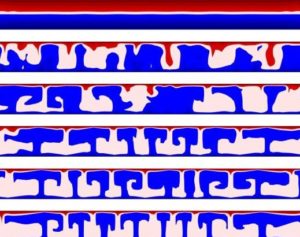[January 2017 – May 2018]
 This project grew out of the course MEAM646 Computational Mechanics instructed by the CFD expert Dr. Howard Hu. The course mainly teaches basic concepts including matrix solving, FVM(finite volume method), SIMPLER algorithm, staggered grid implementation and other techniques that enable accurate and efficient computing of 2D transport equations. A C-based program was provided for us to test and to build projects on. I decided to extend the capability of the program to simulate double-diffusive turbulence and for the final project, I planned to use level-set method to simulate multi-phase flow.
This project grew out of the course MEAM646 Computational Mechanics instructed by the CFD expert Dr. Howard Hu. The course mainly teaches basic concepts including matrix solving, FVM(finite volume method), SIMPLER algorithm, staggered grid implementation and other techniques that enable accurate and efficient computing of 2D transport equations. A C-based program was provided for us to test and to build projects on. I decided to extend the capability of the program to simulate double-diffusive turbulence and for the final project, I planned to use level-set method to simulate multi-phase flow.
Double-diffusive turbulence is rooted from buoyancy-driven instability where temperature and salinity contribute adversely to the density with one having the stabilizing effect and another destabilizing the system. The fact that the magnitude of the two scalars’ influences on the density is different and that their diffusivities are different makes the parametric space multi-dimensional.
This instability is especially dominant in oceanography. The surface of the ocean is usually warmer due to the radiation absorption and saltier due to the evaporation compared to the bottom of the ocean. Once the the fluid surface is perturbed, suppose a fluid parcel from the upper layer have a chance to dive down, the fluid parcel quickly give away heat to the environment(the diffusivity of temperature is higher) and become even denser. As a result, the instability develops and the interplay between the flow and the scalars give rise to rich behaviors.
In 2016, a very good paper was published in PNAS on this topic, stressing the beautiful transition from dampingregime(stabilizing scalar dominant) to the salt-finger regime(comparable influence from the two scalars), and ultimately to a more structured, cell-based Benard circulation regime(stabilizing scalar drops out). The figure on the top is my replication of this result. By varying buoyancy ratio, from top to down, I was able to simulate the transition between regimes. I also got comparable result in Nusselt numbers and Reynolds numbers in a statistically averaged fashion.
